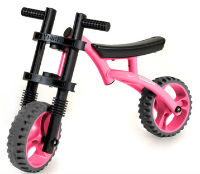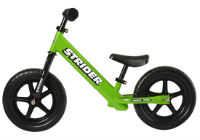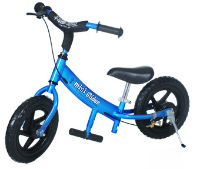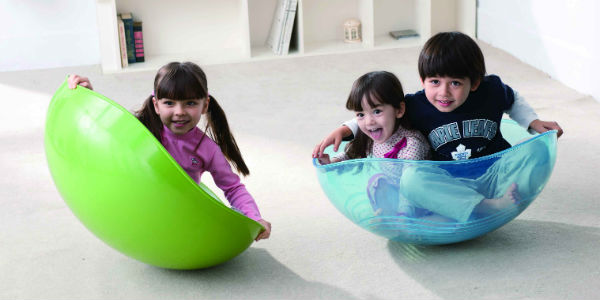
Products
Kids can promote core and arm strength while using the rocking bowl to balance. Don’t worry! Kids won’t tip over. The rocking bowl can be used upside down to climb, sit, stand or even hide under during active and pretend play fun. The rocking bowl has a wave design so that kids can’t pinch their fingers.
Price: $199.99
Chairs like Tumble Forms offer security, durability, and adaptability for children to access the world around them independently. Tumble Forms give a child the ultimate positioning for accessibility during interactions with friends and family.
Prices varied
This product encourages exploration for children just learning to walk. Favorite toys can be hung down the sides and the tray offers a place for other incentives to be placed for baby to walk encouraging balance and muscle strength in the legs and arms. The First Toddle Baby Gym grows with your child- it can turn into a soccer net or basketball hoop to engage in pretend play and cognitive development.
Price: $129.95
The Learning Tower offers parents peace of mind when little ones want to help! The sturdy step stool is adjustable in height and has non-tip construction. It is big enough for two kids to share space to play or help out. The Learning Tower offers accessories like the Playhouse Kit and Art Easel to expand play!
Price: $199.99 (accessories extra)
Springfree offers excellent options for outdoor trampolines that can be used year around (yes, even in the snow!). The trampoline does not use steel for the frame or springs and the enclosure poles flex away from the net to ensure safety when trampolining. Great way to learn balance, explore body movements and improve mood at the same time. Price: $1,200+
An indoor trampoline like the Little Tikes 3 Foot Trampoline can be an excellent resource for burning some energy and creating focus and attention to tasks like homework or dinner for a child with lots of wiggles. The trampoline has a large jumping surface, handle bar for stability and padding for safety. It is perfectly sized for one jumper at a time and great for kids to get moving indoors. Price: $79.99
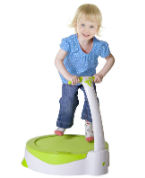 This trampoline is made for the youngest of bouncers honing in on gross motor and balance skills from the start! The Bubble Bouncer is small in size, low to the ground and provides just the right amount of bounce for little ones. The handle is sturdy to help with balance and coordination and is removable to slide the trampoline out of the way. Price: $49.99
This trampoline is made for the youngest of bouncers honing in on gross motor and balance skills from the start! The Bubble Bouncer is small in size, low to the ground and provides just the right amount of bounce for little ones. The handle is sturdy to help with balance and coordination and is removable to slide the trampoline out of the way. Price: $49.99
These bikes are offered in three sizes to serve different ages and stages. The Pewi is for little ones and includes 4 wheels for maximum stability, the Balance Bike offers 2 wheels and no pedals and the Extreme Bike offers higher handle bars and a wider base to increase the level of difficulty promoting core strength and balance. Cool design of these bikes gives them street creds, too.
Strider Bikes are well known in the competition arena offering older kids bikes to work on tricks and stunts on trails and ramps. The SS-1 “Super 16” bike is light with no pedals allowing older kids to focus on the task at hand while building confidence along with balance.
Glide Bikes offers the Super Glider with no pedals for people over 6 feet tall. This option is great for older and taller kids that have not mastered the art of riding a bike, but still want to be included in the family bike rides. Never too late to learn balance skills that help maintain health and wellness.
10 Great Balance Toys For A Child With Special Needs
One of the key elements to gross motor skills is balance. Balance allows control of movements during stationary (static) as well as moving (dynamic) tasks like laying, sitting, crawling, walking, or running.How Balance Works
Ears play a large role in balance due to the vestibular system which arises in the inner ear and is responsible for processing movement, changes in head positions and the direction and speed of movement. The vestibulocochlear nerve sends signals to the brain that control hearing and ultimately helps with balance. The ears receive assistance from the eyes, joints, and muscles too keeping bodies balanced and upright. Balance is something that needs to be learned through experimenting with body movements. There are many toys and play products that can motivate and encourage children to improve their balance. These toys and play products can help teach balance while sitting, standing or even moving- all critical skills for everyday life. Here are toy ideas that will help with balance while sitting, standing or moving:Sitting
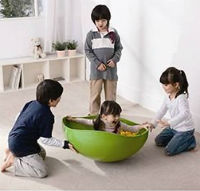 1. WePlay Rocking Bowl
1. WePlay Rocking Bowl
Kids can promote core and arm strength while using the rocking bowl to balance. Don’t worry! Kids won’t tip over. The rocking bowl can be used upside down to climb, sit, stand or even hide under during active and pretend play fun. The rocking bowl has a wave design so that kids can’t pinch their fingers.
Price: $199.99
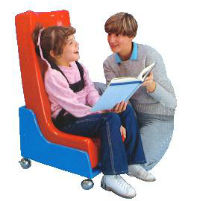 2. Tumble Forms
2. Tumble Forms
Chairs like Tumble Forms offer security, durability, and adaptability for children to access the world around them independently. Tumble Forms give a child the ultimate positioning for accessibility during interactions with friends and family.
Prices varied
Standing
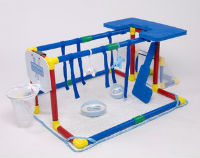 3. First Toddle Baby Gym
3. First Toddle Baby Gym
This product encourages exploration for children just learning to walk. Favorite toys can be hung down the sides and the tray offers a place for other incentives to be placed for baby to walk encouraging balance and muscle strength in the legs and arms. The First Toddle Baby Gym grows with your child- it can turn into a soccer net or basketball hoop to engage in pretend play and cognitive development.
Price: $129.95
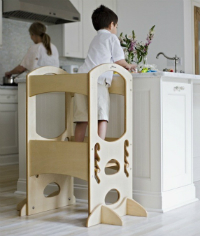 4. Little Partners Learning Tower
4. Little Partners Learning Tower
The Learning Tower offers parents peace of mind when little ones want to help! The sturdy step stool is adjustable in height and has non-tip construction. It is big enough for two kids to share space to play or help out. The Learning Tower offers accessories like the Playhouse Kit and Art Easel to expand play!
Price: $199.99 (accessories extra)
Moving
Trampolines
There are many options for trampolines and picking the right one for your child’s needs will start with research! Three basic options for trampolines may include: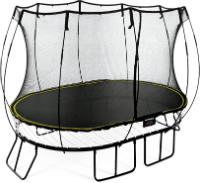 5. Springfree Trampoline
5. Springfree Trampoline
Springfree offers excellent options for outdoor trampolines that can be used year around (yes, even in the snow!). The trampoline does not use steel for the frame or springs and the enclosure poles flex away from the net to ensure safety when trampolining. Great way to learn balance, explore body movements and improve mood at the same time. Price: $1,200+
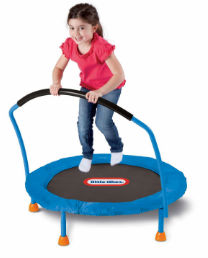 6. Little Tikes 3 Foot Trampoline
6. Little Tikes 3 Foot Trampoline
An indoor trampoline like the Little Tikes 3 Foot Trampoline can be an excellent resource for burning some energy and creating focus and attention to tasks like homework or dinner for a child with lots of wiggles. The trampoline has a large jumping surface, handle bar for stability and padding for safety. It is perfectly sized for one jumper at a time and great for kids to get moving indoors. Price: $79.99
7. Bubble Bouncer
 This trampoline is made for the youngest of bouncers honing in on gross motor and balance skills from the start! The Bubble Bouncer is small in size, low to the ground and provides just the right amount of bounce for little ones. The handle is sturdy to help with balance and coordination and is removable to slide the trampoline out of the way. Price: $49.99
This trampoline is made for the youngest of bouncers honing in on gross motor and balance skills from the start! The Bubble Bouncer is small in size, low to the ground and provides just the right amount of bounce for little ones. The handle is sturdy to help with balance and coordination and is removable to slide the trampoline out of the way. Price: $49.99


